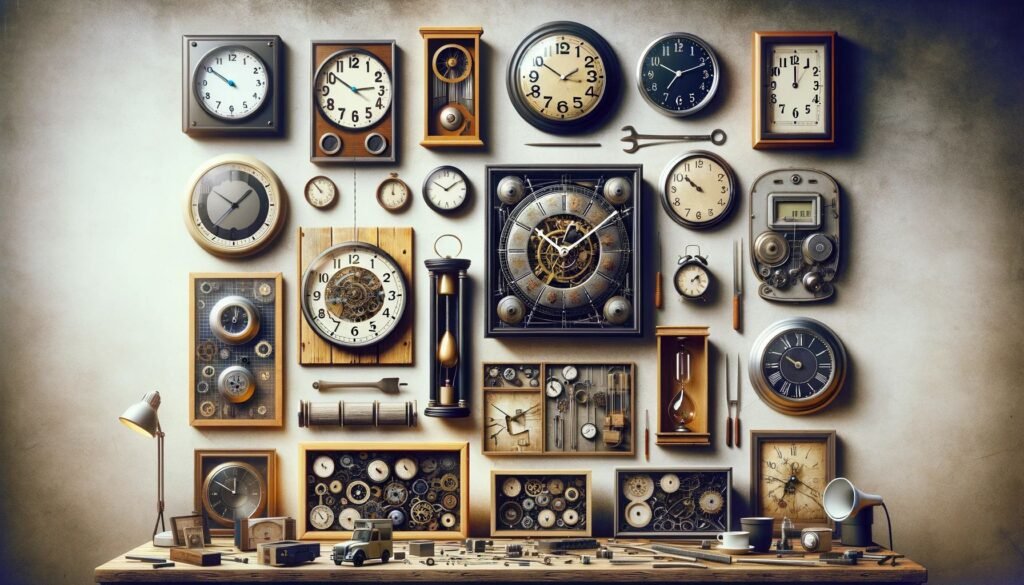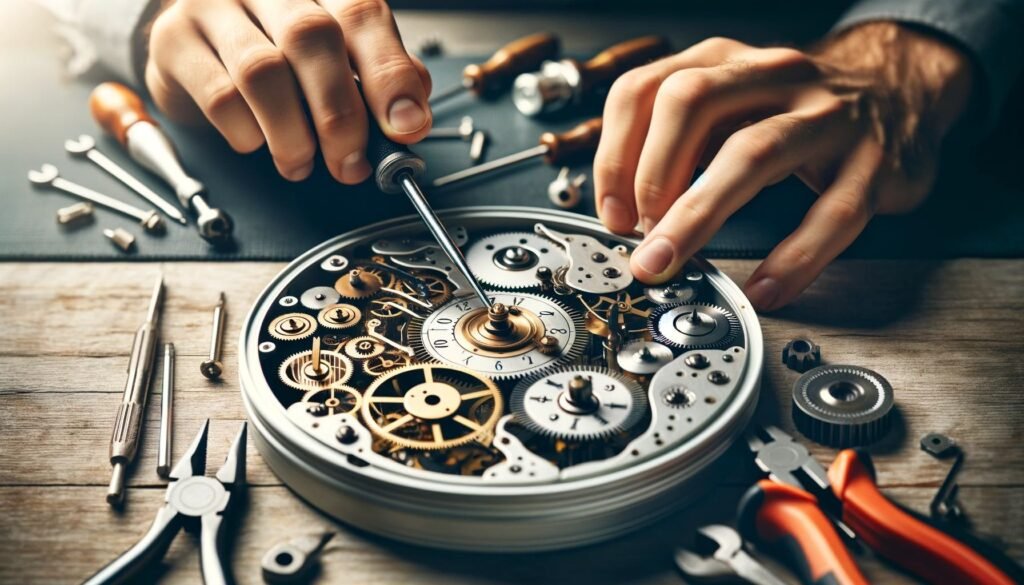Discover step-by-step instructions on How to Fix a Broken Wall Clock and restore its functionality. Learn how to fix common issues with precision and confidence.
The process of repairing a broken wall clock can sometimes seem daunting, but with the right guidance, it can be a rewarding and fulfilling experience. In this comprehensive guide, we will explore the key steps and considerations for effectively resolving common issues with wall clocks.
Whether it’s a stopped pendulum, malfunctioning gears, or a cracked frame, this article will equip you with the knowledge and confidence to tackle the repair process with ease, ultimately restoring your wall clock to its former glory.
Understanding the Mechanics of a Wall Clock

Understanding the internal workings of a wall clock is crucial before attempting any repairs. Most wall clocks consist of essential components such as the clock face, hands, pendulum (if applicable), clock movement, and power source. The mechanism varies based on the type of wall clock, whether it’s analog, digital, pendulum, or quartz. It’s important to identify the specific design and components of your wall clock to address the repair effectively.
Identifying the Problem
Common Clock Issues
- Stopped pendulum
- Malfunctioning gears
- Cracked or broken frame
Troubleshooting
- Checking for battery power
- Assessing gear movement
- Observing pendulum behavior
Seeking Professional Help
It’s essential to recognize when a problem may require professional intervention. If the issue seems beyond your expertise or involves delicate components, seeking the assistance of a professional clock repair service may be the best course of action.
Tools and Materials Needed
Before getting started, gather the necessary tools and materials for the repair. This may include:
- Screwdrivers (various sizes)
- Pliers
- Small hammer
- Replacement clock movement
- Super glue or epoxy for frame repair
- Paint and finish for cosmetic touch-ups
Preparing Your Workspace
Creating a conducive workspace is vital for a successful repair. Consider the following steps:
- Clear a well-lit work area.
- Lay down a soft cloth to prevent damage to the clock and its components.
- Organize the tools and materials for easy access.
Fixing the Clock Frame
Addressing a Cracked or Broken Frame
If the frame of your wall clock has sustained damage, consider the following:
- Use epoxy or super glue to carefully mend the broken pieces.
- Replicate missing parts using resin or clay, ensuring a snug fit.
- Sand and repaint the repaired area for a seamless finish.
Repairing Internal Mechanics

Steps to Fix Malfunctioning Gears
- Open the clock case and identify the gear train.
- Inspect for any worn or broken gears, and replace as necessary.
- Lubricate the gears with clock oil for smooth operation.
Resolving Pendulum Issues
If the pendulum isn’t swinging or moving as expected:
- Ensure the pendulum is properly attached and free from obstruction.
- Adjust the suspension spring to optimize pendulum movement.
Solving Power Issues
Battery-Powered Wall Clocks
- Replace the old batteries with fresh ones.
- Clean the battery contacts to ensure a secure connection.
Electric Wall Clocks
- Check the power source and connections for any issues.
- Ensure the power cord is intact and firmly connected to the clock.
Cosmetic Repairs and Adjustments
Addressing Aesthetic Imperfections
- Use touch-up paint to repair scratches and blemishes on the clock frame.
- Clean and polish the clock face and glass cover for a pristine appearance.
Calibrating and Testing
After conducting repairs, verifying the clock’s accuracy is crucial:
- Adjust the clock hands to the correct time.
- Monitor the clock for a full cycle to ensure smooth operation.
- Calibrate the clock movement as needed for precise timekeeping.
Maintenance Tips to Avoid Future Breaks
To prevent future issues with your wall clock, consider the following maintenance tips:
- Regularly clean and dust the clock and its components.
- Periodically oil the clock movement for smooth operation.
- Conduct routine inspections to detect any potential issues early on.
Professional Help and Services
While this guide empowers you to handle various repairs, some situations may warrant professional assistance. Depending on the complexity of the issue, seeking the expertise of a clock repair specialist can ensure comprehensive and reliable repairs.
Additional Maintenance Tips
- Dust and Clean Regularly: Regular dusting and cleaning of the clock’s exterior, including the clock face and hands, helps prevent dust buildup and extends the lifespan of the timepiece.
- Humidity Control: Maintain a consistent indoor humidity level as extreme fluctuations can affect the clock’s movement and components. Consider using a dehumidifier in damp environments.
Types of Wall Clocks
- Analog vs. Digital: A comparison of analogue and digital wall clocks, including their distinct maintenance requirements and common issues to look out for in each type.
- Pendulum Wall Clocks: Specific maintenance considerations for pendulum wall clocks, such as pendulum adjustment and ensuring smooth swinging motion.
Wall Clock Restoration Techniques
- Antique Wall Clocks: Tips for maintaining and restoring antique wall clocks, including precautions for handling delicate components and preserving historical integrity.
- Wooden Wall Clocks: Maintenance advice for wooden wall clocks, including varnishing and polishing techniques to preserve the wood’s integrity.
Preventive Maintenance Benefits
- Longevity of Timepieces: Emphasize how regular maintenance can prolong the lifespan of a wall clock, ensuring years of reliable timekeeping.
- Enhanced Aesthetics: Discuss how proper maintenance not only ensures functionality but also preserves the clock’s aesthetic appeal.
Conclusion
In conclusion, the process of fixing a broken wall clock encompasses various considerations and steps. By following the comprehensive guidance provided in this article, individuals can confidently address a wide range of issues affecting their wall clocks.
The satisfaction of restoring a cherished timepiece to its former functionality and aesthetic appeal is a rewarding experience. Remember, with patience, attention to detail, and a willingness to learn, repairing a broken wall clock can be a fulfilling endeavour.
FAQs
What are the common issues with wall clocks?
The most common issues include stopped pendulums, malfunctioning gears, and cracked or broken frames.
When should I seek professional clock repair services?
If a repair involves delicate components or seems beyond your expertise, it’s best to seek the assistance of a professional clock repair service.
How can I prevent future issues with my wall clock?
Regular maintenance, such as cleaning, oiling, and routine inspections, can help prevent future issues with your wall clock.
Read More:
- Clock Stopped Ticking? Learn How To Fix A Wall Clock That Stopped Working
- 8 Unique Wall Clocks for Living Room: Transform Your Space With Timeless Elegance.
- Bulova Wooden Atomic Analog Wall Clock Review: A Timeless Blend of Precision and Style
- How to Fix a Pendulum Wall Clock: Quick and Easy Ways to Fix
- Home Decor Game Changer: Learn How To Hang A Clock On The Wall-Step-by-Step Guide
- How High to Hang a Large Wall Clock: A Comprehensive Guide

